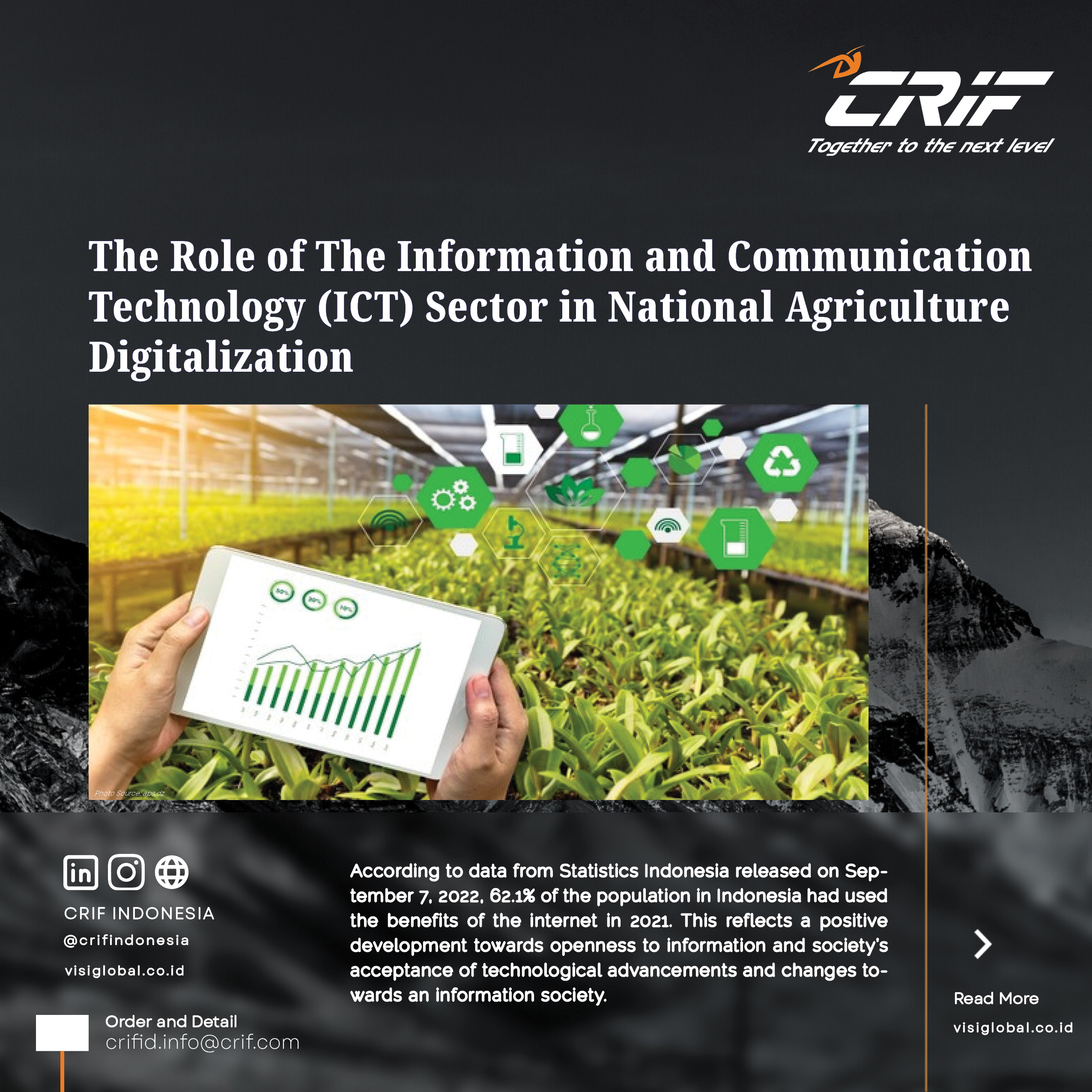62.1% of the population in Indonesia had used the benefits of the internet in 2021. This reflects a positive development towards openness to information and society's acceptance of technological advancements and changes towards an information society.
According to data from Statistics Indonesia released on September 7, 2022, 62.1% of the population in Indonesia had used the benefits of the internet in 2021. This reflects a positive development towards openness to information and society's acceptance of technological advancements and changes towards an information society.
In terms of numbers, the Information and Communication Technology (ICT) sector experienced an average growth of 0.89 points per quarter (Y-o-Y). In Q4/2022, the sector experienced positive growth of 2.54 points (Y-o-Y) compared to the same period in 2021.

Based on this growth and the past few years, CRIF predicts that at the beginning of 2023, the sector will experience growth of 8.07% (Y-o-Y) in Q1 and 8.90% (Y-o-Y) in Q2. This growth is driven by the digitalization of the industry carried out by all industrial sectors. In addition, the ITC sector is predicted to experience positive growth throughout 2023, reaching 10.26% (Y-o-Y).
The Role of the ICT Sector in Agriculture
The digitalization of the agricultural sector has been in the spotlight of the government as the use of digital technology in agriculture is a factor in increasing national income through the income of millennial farmers. The presence of digital technology can provide timely and relevant agricultural information, which allows farmers to make informed decisions about agriculture. Digital technology can improve farmers' accessibility to market information, commodity inputs, consumer trends, and other agricultural information that has a positive impact on the quality and quantity of products (Lubis, 2010). Moreover, as we enter the era of Industry 4.0, all activities are inseparable from automation that is connected to the internet network and digital technology in general.

The use of digital technology in the form of smartphones/mobile phones has the highest impact on the income of millennial farmers. Its tendency is greater compared to computers, which is 1.75 times (compared to millennial farmers who do not use it in agricultural work). On the other hand, the use of other digital technologies (digital cameras, digital scales, digital calculators, and other digital tools) has no effect on the average income of farmers. This can happen because only 1.6% of millennial farmers use digital technology. Nevertheless, it is still possible that the use of digital technology by a small fraction of millennial farmers can increase their average income. Based on the model, it was found that millennial farmers who use digital technology are 1.74 times more likely to have higher average income than those who do not use it. Meanwhile, the use of digital technology in the form of computers (PCs, notebooks, laptops, tablets, or PDAs) is quite effective in increasing farmers' income. Millennial farmers who use digital technology have a 1.38 times greater chance of having above-average income compared to those who do not use it. (BPS, 2023)
Labor Absorption Capacity in the ICT Sector
Business fields in the ICT sector are predicted to be consistent in maintaining economic growth, moreover, Indonesia's digital economy potential is expected to grow rapidly in the next few years. The value of the digital economy in Indonesia reaches USD 77 million, an increase of 22% from the previous year (2021). Even in 2025 it is predicted to reach USD 130 million (Google, Temasek & Bain, 2022).
Apart from the large population, other factors affecting the value of Indonesia's digital economy are the amount of access and intensity of users towards online media such as videos, music and video games. The intensity of media use is much higher than the achievements of Southeast Asia in general.

The economic activity in the ICT sector has emerged as one of the backbones of the national economy during the COVID-19 pandemic. The value added of the ITC sector grew by 10.61% (Y-o-Y) in 2020 while the overall economic growth experienced a contraction. On the other hand, the ICT sector's economic growth during 2010-2022 has always been above average.
Overall, the use of internet by the workforce in the ICT sector is very good. It ranks highest compared to other job fields. The internet usage in this business sector has reached 97%. If the ICT infrastructure readiness is continuously improved, Indonesia's competitiveness is expected to also increase. Currently, Indonesia's Transformation Readiness Index related to ICT infrastructure ranks second to last out of 37 observed countries (WEF, 2021).
Percentage of Workforce Using Internet in Their Occupations According to Business Fields 2021
The Role of the ICT Sector of People's Welfare Indicators
According to SUSENAS (National Socioeconomic Survey) data, the population who own mobile phones has increased from 59.59% in 2017 to 65.87% in 2021. As mobile phone ownership increases, the population using mobile phones has also significantly increased from 68.59% in 2017 to 81.28% in 2021. The increase in mobile phone users is related to the increasingly sophisticated benefits of mobile phones, making them an inseparable part of human life in the modern era.
Currently, mobile phones are not only a communication tool, but have more complex functions. Mobile phones can be used to take photos, email, online shopping, work remotely, as a digital wallet, for banking transactions, and more. It is not surprising that people's lives, especially in big cities, depend heavily on mobile phones. The increasing use of mobile phones is also inseparable from the widespread coverage of mobile signals and networks (lokadata.id, 2022).
The positive impact is that people find it easier to find business opportunities, both offline and new online-based businesses. The same goes for business development and recruitment processes. This indirectly shows the contribution of the ITC sector in improving the economy of technology users.
